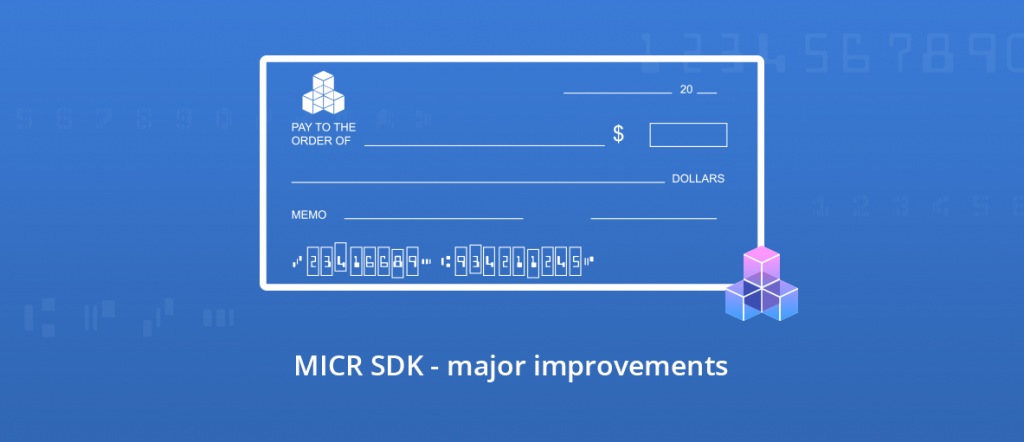Major Improvements of the MICR Detection and Recognition Engine

Hi Everyone,
In March we have significantly enhanced our MICR engine, in such a way that we announced the new performances and improvements in a press release.
But this was before last week’s release, which brought even better performances to the toolkit.
We’re proud to have a fast and robust tool that can be a strong base for any banking and financial application.
So we thought it was a good opportunity to write a recap article about MICR and present our tool to those who are not using it yet.
What is MICR?
MICR stands for Magnetic Ink Character Recognition.
The MICR technology uses magnetic ink on cheques for automatic reading and security reasons. Indeed, the magnetic ability makes the clearing of cheques faster, and the special ink and printers mitigate check fraud.
If you wish to know more about the history of MICR (the technology was invented in the fifties!), you can read the article we wrote on the ORPALIS blog.
So, MICR is a standard encoding technology and it uses two different fonts, E-13B and CMC-7.

The MICR line is located at the bottom of a cheque.
Both MICR fonts use the 10 decimal digits and a set of additional symbols that provide the document type indicator, bank code, bank account number, check number, the amount, and a control indicator.
The E-13B font

MICR E-13B font characters.
In E13-B, the E means that it was the 5th version of the font considered.
The B signifies that it was the second revision of that font, and the 13 refers to the fact that the MICR font is constructed on a .013” module for stroke and character width.
This font was invented in the US by the same group that developed the MICR technology, Stanford Research Institute and General Electric Computer Laboratory. It is primarly used in North America and English-speaking countries.
The CMC-7 font

An example of CMC7 MICR characters.
This font was developed in France in 1957, and it is (mostly) used in Europe and South America.
CMC-7 means in French “Caractères Magnétiques Codés à 7 bâtonnets”, which can be translated into “7-Stick Coded Magnetic Characters.”
It’s actually a linear barcode (made of 7 lines) in the shape of ten numbers and five symbols.
The only country that uses both fonts is Israel, with the Israelis using CMC-7 and the Palestinians E-13B.
The MICR challenges
- CMC-7 readability
If OCR engines can read E13B quite easily, it’s much more difficult for the barcode-like CMC7 font with all the fine lines that can blend together easily when scanned with a poor resolution.
- when a signature overlaps the MICR zone
- MICR zone detection in any location and orientation of the document.
And like any other OCR engine, it can be difficult to get accurate results on poorly contrasted and skewed images.
The GdPicture.NET MICR SDK
In 2012, we developed a first version of the recognition engine to detect and decode the MICR line from any structured document by analyzing the whole page layout.
At the time, it was working quite well and we even received a grant from the French government for our research and development work.
Similarly to all the other engines of our SDK, we’re constantly working on MICR improvements.
We use several tools and methods, including artificial intelligence, machine learning, and fuzzy logic algorithms to get the best results.
The recognition engine is now remarkably accurate with skewed, poorly contrasted, and hard to read documents. It can also decode the characters when the signature overlaps the MICR zone.
MICR: an OCR special context
The MICR functionalities belong to a series of special context methods of our OCR engine.
A special context allows triggering a specific layout analysis and OCR engines in order to maximize accuracy and speed on the detection of specific items. It is particularly useful when you only need to decode a small zone of a document, not the full document.
Besides MICR, several special contexts are available in the SDK:
- MRZ (Machine Readable Zone) for IDs, passports, and visas
- one or two numerics
- or single-line numerics (in labels for instance)
As usual, the demo is available in both C# and VB.NET in the WinForm folder, also available as a compiled application in the Bin folder located in [INSTALLATION FOLDER]/Samples/.
More special contexts can be added on-demand by our team of researchers, feel free to contact us if you need anything.
Last but not least, you will find all MICR improvements in the latest release. Try it and let us know what you think!
Cheers,

As CEO, Jonathan defines the company’s vision and strategic goals, bolsters the team culture, and steers product direction. When he’s not working, he enjoys being a dad, photography, and soccer.
Tags:
